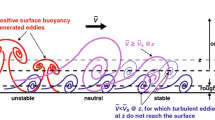Summary
Horizontal flux of enthalpy and latent heat has been computed from synoptic maps over a large part of the northern hemisphere for several isobaric levels during 3 months. The flux of enthalpy and also the flux of latent heat is lowest in July and 3 to 4 times larger in winter. The flux is largest at 850 mb. The large scale eddy conductivity for the enthalpy increases with the horizontal meridional temperature gradient showing that the atmospheric energy exchange processes become more effective when the gradients are strong. From the convergence of the flux values the mean heating of an air column has been computed. This heating has a winter maximum of about 1° C/24 hrs at latitude 60°–70° N. The values for the polar region are considerably lower, indicating a considerable mean descending motion in the region. The correlation between flux or convergence of flux and circulation indices is found to be rather small. There is even a negative correlation between convergence of enthalpy and the zonal index.
Zusammenfassung
Der horizontale Transport von Enthalpie und latenter Wärme wurde auf Grund von Wetterkarten für verschiedene Druckniveaus über einem großen Teil der nördlichen Hemisphäre für drei verschiedene Monate berechnet. Sowohl der Enthalpie- wie der latente Wärmestrom ist am geringsten im Juli und drei- bis viermal größer im Winter; am größten ist er bei 850 mb. Der Großaustauschkoeffizient der Enthalpie nimmt mit dem horizontalen meridionalen Temperaturgradienten zu, was sich durch die Steigerung der atmosphärischen Energieaustauschprozesse bei Verstärkung des Gradienten erklärt. Aus der Strömungskonvergenz wurde die durchschnittliche Erwärmung einer Luftsäule berechnet. Diese Erwärmung zeigt ein Maximum von zirka 1° C/24 Studen im Winter in einer Breite von 60 bis 70° N. Die Werte für das Polargebiet sind beträchtlich niedriger und lassen eine merkliche absinkende Strömung erkennen. Die Korrelation zwischen Strömung oder Strömungskonvergenz und Zirkulationsgrößen hat sich als eher niedrig erwiesen. Die Korrelation zwischen der Konvergenz der Enthalpie und dem Zonalindex ist sogar negativ.
Résumé
Le flux horizontal d'enthalpie et de chaleur latente a été calculé à partir de cartes synoptiques couvrant une grande partie de l'hémisphère nord et cela pendant 3 mois pour plusieurs niveaux isobariques. Le flux d'enthalpie ainsi que celui de chaleur latente est à son minimum en juillet et est 3 à 4 fois plus grand en hiver. Le flux le plus important se trouve au niveau de 850 mb. Le coefficient de la conductivité turbulente de l'enthalpie à grande échelle croît avec le gradient horizontal méridional de température, et montre ainsi que les processus de l'échange d'énergie atmosphérique augmentent avec la force du gradient. L'auteur a calculé le réchauffement moyen d'une colonne d'air en partant de la convergence des valeurs du flux. Ce réchauffement atteint un maximum hivernal d'environ 1° C/24 h à 60°–70° de latitude N. Les valeurs des régions polaires sont notablement plus petites et laissent reconnaître un mouvement descendant considérable dans cette région. La corrélation entre le courant ou la convergence de flux et les valeurs de la circulation s'est avérée plutôt petite. Il y a même une corrélation négative entre la convergence de l'enthalpie et l'index zonal.
Similar content being viewed by others
References
Ångström, A.: Evaporation and precipitation at Various Latitudes and the Horizontal Eddy Convectivity of the Atmosphere. Ark. Astr. Fys.,19, A, No. 20 (1925).
Defant, A.: Die Zirkulation der Atmosphäre in den gemäßigten Breiten der Erde. Geogr. Ann.3, 209 (1921).
Mintz, Y.: The geostrophic poleward flux of sensible heat in the month of January 1949. Investigation of the General Circulation. Part I, Report No. 8. University of California, Los Angeles 1951.
Nyberg, A., T. Duvedal, andS. Fryklund: Transport of heat and momentum by horizontal large scale eddies in November 1947, July 1949 and February 1950 north of 40° N. Sverig. Meteorol. Hydrol. Inst. Not. o. prelimin. Rapport. M. B. Vol. I. No. 4. Stockholm (1954).
Nyberg, A., andE. Schmacke: Eddy Flux of Heat and Momentum during Two Years at Stockholm-Bromma. Tellus3, 89 (1951).
Palmén, E., andM. A. Alaka: On the Budget of Angular Momentum in the Zone between Equator and 30° N. Tellus4, 324 (1952).
Priestley, C. H. B.: Heat Transport and Zonal Stress between Latitudes. Quart. J. Roy. Met. Soc.75, 323 (1949).
—: Physical interactions between tropical and temperate latitudes. Quart. J. Roy. Met. Soc.77, 200 (1951).
Scherhag, R.: Untersuchungen der troposphärischen Kältepole der höheren Breiten. Geophysica4, 146 (1953).
Starr, V. P.: An essay on the general circulation of the earth's atmosphere. J. Meteorol.5, 89 (1948).
Sverdrup, H. U.: Oceanography for meteorologists. London 1945.
White, R. M.: a) The meridional eddy flux of energy. Quart. J. Roy. Met. Soc.77, 188 (1951).
—: b) The Meridional Flux of Sensible Heat over the Northern Hemisphere. Tellus3, 82 (1951).
Author information
Authors and Affiliations
Additional information
With 6 Figures.
Rights and permissions
About this article
Cite this article
Nyberg, A. Meridional heat transport on a part of the northern hemisphere in November 1947, July 1949, and February 1950. Arch. Met. Geoph. Biokl. A. 7, 99–113 (1954). https://doi.org/10.1007/BF02277909
Issue Date:
DOI: https://doi.org/10.1007/BF02277909




